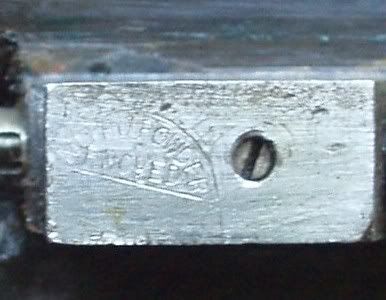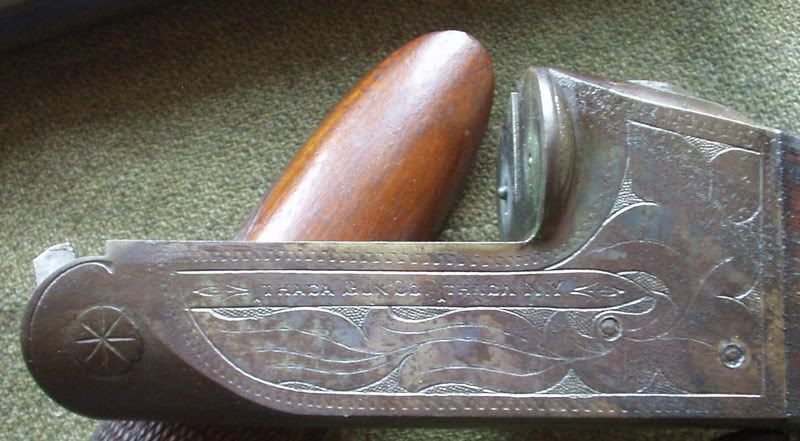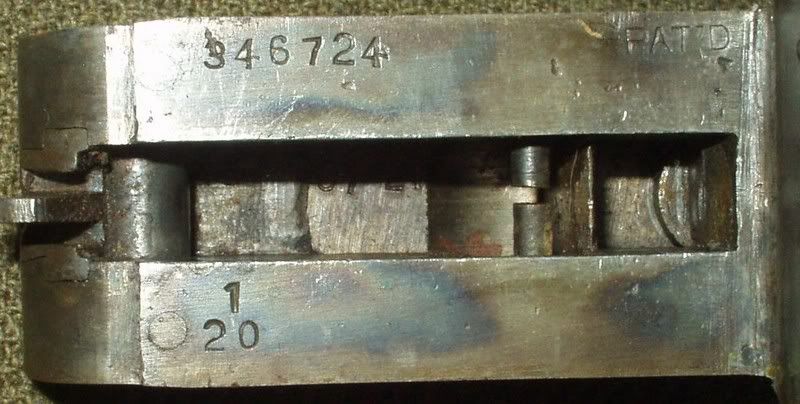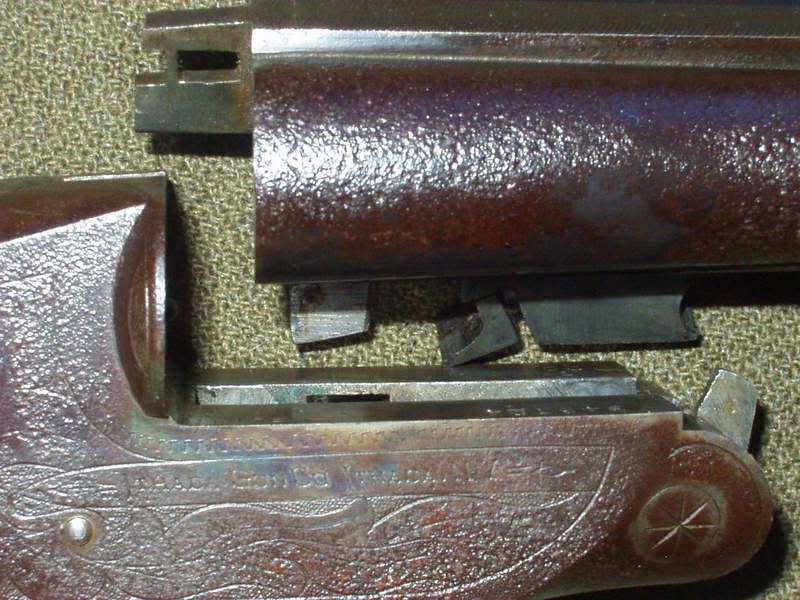I have an Ithaca shotgun. That's a photo of it overall at the top of this article. I got this shotgun by means of inheritance from my maternal-grandfather. Whence it came to his hands I've not much information. My mother, if she ever knew, can't tell me. I believe that he got it to use around his "farm" in Warren County, New Jersey, near Plainfield about the time they moved there ca. 1930. Manfactured in 1920, it must have been purchased used. Not a lot of history there except it was Grandfather's and he used it.
Grandfather graduated from MIT and started working for the telephone company (there was only one at the time) as a lineman. He was trained as an electrical engineer and moved on up to management at AT&T (ma Bell) before retiring. Grandfather was not a hunter. He shot as a practical exercise in controlling vermin in his garden. This was important because they subsisted in large part on the produce from this garden. Grandmother canned what Grandfather grew on their 12 acres. It was a pretty rocky bit of land and I think Grandfather was mighty careful with all that came from that land. He was almost notoriously tight with money but he came by it honestly. His parents having lost nearly everything in the "crash" opened a small store in South Braintree, MA and made a living from it.
What Grandfather did love was sailing and boats and sailing and the water and sailing. Before the "crash" his family had owned a yawl. With cabins and amenities I remember looking at the photos and wondering why they no longer had it. I didn't understand about the "crash". So, when Grandfather could put together some money, his money went to boats, to sailing, to traveling to where there were boats and sailing. That's about all, other than Grandmother and my mother, he cared about. The guns were not at the top of his priority list.
Grandmother also loved sailing. Her family was solidly upper middle class and a long line of government servants and civil engineers. She had summered on Lake George from the time she was a very young girl as her Grandfather had built one of the first summer places on the lake, in the bay just south of Sabbath Day Point. She too loved boats and sailing and the water. She cared nothing for hunting or shooting and despite her other rather right wing views she and her four sisters were stolid anti-gun people.
It was because of Grandmother that, when the garden no longer loomed large in their life of plenty, Grandfather retired the guns to the attic. There they rested for at least 40 years. I don't think much thought was paid to them except when I, learning of their existence, was denied a chance to look on this aspect of familial history. It was an incongruity that stuck in my mind and never let me forget about those guns, whatever they were.
When Grandmother died, several years after Grandfather, my parents retrieved the guns from the attic of her home and delivered them to me. Of one you have read, it is the 1906 Winchester which needed to be completely refinished due to the fine rust all over the outside of the gun. So the Ithaca is in the worst condition of the other 3 guns (of which I will write later) and so the first I've now taken from the case with the hope that she can be rejuvenated.
To lay it out for any who wish to see the before and might also wish to comment on how best to approach the problem, I will now post a few photos with comments. The photos may be small but if you click on them, you can see them full size (as with any other photos in this journal).
 The gun is an Flues model Ithaca side by side 20 gauge shotgun, "engraved", colorcased, double triggers, and nitro prooved as shown by the stamp in the photo. It has 2-3/4 inch chambers and is apparently choked modified and full. The gun has extractors as opposed to ejectors. I have fired it. I have taken game and 1 crow with it. Being about average in height and proportions, it fits me fairly well. Grandfather was about my height (5' 8"). I imagine it fit him well, too. Apparently his father had a 12 ga. shotgun (of which more later) and he didn't like the "kick" which is why he got the 20 gauge. He might have been thrifty but he believed that quality was a better value than the simply cheap. I imagine that there were a lot of blackpowder guns out there for less money but he didn't buy one of those.
The gun is an Flues model Ithaca side by side 20 gauge shotgun, "engraved", colorcased, double triggers, and nitro prooved as shown by the stamp in the photo. It has 2-3/4 inch chambers and is apparently choked modified and full. The gun has extractors as opposed to ejectors. I have fired it. I have taken game and 1 crow with it. Being about average in height and proportions, it fits me fairly well. Grandfather was about my height (5' 8"). I imagine it fit him well, too. Apparently his father had a 12 ga. shotgun (of which more later) and he didn't like the "kick" which is why he got the 20 gauge. He might have been thrifty but he believed that quality was a better value than the simply cheap. I imagine that there were a lot of blackpowder guns out there for less money but he didn't buy one of those. As you can see in this photo of the left side of the gun, it is clearly marked as an Ithaca Gun Company product. I don't know if this is really engraving though. It has the appearance of just enough to be marketed as engraving. They weren't casting receivers at this time, I don't think, so I don't think this is cast. If you look closely, you might see some of the color case.
As you can see in this photo of the left side of the gun, it is clearly marked as an Ithaca Gun Company product. I don't know if this is really engraving though. It has the appearance of just enough to be marketed as engraving. They weren't casting receivers at this time, I don't think, so I don't think this is cast. If you look closely, you might see some of the color case. You can see the case colors much better in this photo of the receiver bottom. I love color case and I can imagine that this was a glorious gun when new. Oh, how I wish I'd been more persuasive 35 years ago. If only I could have gained access to those guns. What beauties they once were. What a waste! Still, even now, I don't want to write the old girl off as a lost cause and want to know more about her.
You can see the case colors much better in this photo of the receiver bottom. I love color case and I can imagine that this was a glorious gun when new. Oh, how I wish I'd been more persuasive 35 years ago. If only I could have gained access to those guns. What beauties they once were. What a waste! Still, even now, I don't want to write the old girl off as a lost cause and want to know more about her. Here is the water table. The serial is shown in the upper left and to the right of that is "PATD" for patented. The only other marks are in the lower left, "1" over "20". "20" is obviously 20 gauge, the "1" for grade. This is the standard layout for an Ithaca shotgun.
Here is the water table. The serial is shown in the upper left and to the right of that is "PATD" for patented. The only other marks are in the lower left, "1" over "20". "20" is obviously 20 gauge, the "1" for grade. This is the standard layout for an Ithaca shotgun. The underside of the breach is a bit hard to read in the photo and I apologize for that. For some reason a good photo was very difficult to get with my camera. The first thing to note is the 6-digit serial number. Then forward of the serial, under the left barrel is the numeral "4" and below it in the photo, on the right barrel, is the numeral "2". I presume that these are designations of choke with "4" being "full" and "2" being "improved cylinder" but I've tested and it patterned closer to modified. Then again, I was using modern ammo with a shotcup as opposed to papercased ammo with only wadding as would have been used when the gun was built. Further forward on the left barrel (upper barrel in the photo) There is a "1" with a "6" over a "M" or is it a "9" under a "W"? On the right (bottom of photo) barrel you see a "3" in that position. The only other mark is a 1 very near the left barrel extractor. I would be happy to hear/learn what these marks mean.
The underside of the breach is a bit hard to read in the photo and I apologize for that. For some reason a good photo was very difficult to get with my camera. The first thing to note is the 6-digit serial number. Then forward of the serial, under the left barrel is the numeral "4" and below it in the photo, on the right barrel, is the numeral "2". I presume that these are designations of choke with "4" being "full" and "2" being "improved cylinder" but I've tested and it patterned closer to modified. Then again, I was using modern ammo with a shotcup as opposed to papercased ammo with only wadding as would have been used when the gun was built. Further forward on the left barrel (upper barrel in the photo) There is a "1" with a "6" over a "M" or is it a "9" under a "W"? On the right (bottom of photo) barrel you see a "3" in that position. The only other mark is a 1 very near the left barrel extractor. I would be happy to hear/learn what these marks mean. As you can see the buttplate has some wear but is in pretty good condition except near the toe of the stock where a bit of the plate has been worn or chipped away. I personally love the old style buttplates such as this. They have so much more character than a simply flat piece of plastic or rubber. This buttplate still fits the stock well. Only one screw, the top one, has suffered from the rust. Fortunately, in spite of or because of how the gun was treated the buttstock is in condition with no chips or cracks and only a few scratches. It does have some paint spatter here and there. One can only wonder how that got there.
As you can see the buttplate has some wear but is in pretty good condition except near the toe of the stock where a bit of the plate has been worn or chipped away. I personally love the old style buttplates such as this. They have so much more character than a simply flat piece of plastic or rubber. This buttplate still fits the stock well. Only one screw, the top one, has suffered from the rust. Fortunately, in spite of or because of how the gun was treated the buttstock is in condition with no chips or cracks and only a few scratches. It does have some paint spatter here and there. One can only wonder how that got there. Now this is the truly sad part of the reveal. This is the worst of the rust that was on any of the four guns. It looks horrible and while it doesn't go all that deep into the metal it may go deep enough to preclude an easy restoration. One can only hope. Certainly, I've long thought that this gun, despite being in a rarer gauge, was not worth the expense. This gun as is is worth about $150-200 and even if fully restored to the point that one couldn't see any of the damage wouldn't be worth the $1000-1200 that a pristine example would bring. Still it would be closer to the condition in which Grandfather bought it and used it before beginning the many years of neglect when he abandoned it to his attic.
Now this is the truly sad part of the reveal. This is the worst of the rust that was on any of the four guns. It looks horrible and while it doesn't go all that deep into the metal it may go deep enough to preclude an easy restoration. One can only hope. Certainly, I've long thought that this gun, despite being in a rarer gauge, was not worth the expense. This gun as is is worth about $150-200 and even if fully restored to the point that one couldn't see any of the damage wouldn't be worth the $1000-1200 that a pristine example would bring. Still it would be closer to the condition in which Grandfather bought it and used it before beginning the many years of neglect when he abandoned it to his attic.For anyone interested, here's just a bit of history of the Flues model Ithaca.
The Flues model Ithaca gun was built on a 3 piece lock invented by Emil Flues. It was introduced in 1908 and produced until 1926. Offered in 10, 12, 16, 20, and 28 gauge this model had the longest production life of any Ithaca double. The serial number range is approximately 175,000 to 399,000. Grades offered were field, 1, 1 Special, 1-1/2, 2, 3, 4, 5, 6, 7, and Sousa.Again, there is nothing really special about this shotgun. Apparently there are some who simply don't like to work on the Flues model. The value of the gun, as is, isn't very high. However, the enormous sentimental value to me might make it worthwhile to restore. Any suggestions and/or comments will be welcome. If you have any such, or information or corrections, please e-mail me at any time.

No comments:
Post a Comment
I only ask that you keep it clean and not spam readers. Thanks.